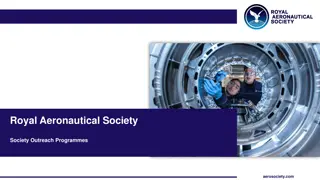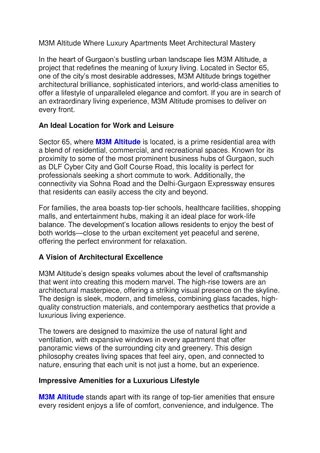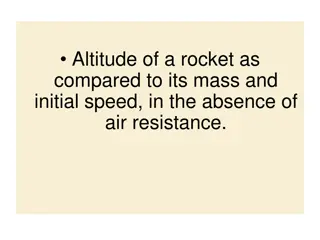Royal Aeronautical Society. Society Outreach Programmes.
Engage with innovative outreach programmes like Cool Aeronautics, Project Altitude, and Falcon 2 offered by the Royal Aeronautical Society to inspire primary and secondary school students in the field of aerospace. Discover opportunities for interactive learning, career exploration, and hands-on exp
0 views • 9 slides
High-Altitude Aeronautical Platform Station Market Trends 2023-2033
The global high-altitude aeronautical platform station (HAAPS) market is estimated to reach $3,338.1 million by 2033 from $1,194.4 million in 2023, growing at a CAGR of 10.82% during the forecast period 2023-2033.\nRead Report Overview: \/\/bisresearch.com\/industry-report\/high-altitude-aeronautica
5 views • 3 slides
VFR Arrival Procedures for Total Solar Eclipse Event on April 8, 2024
In preparation for the Total Solar Eclipse event on April 8, 2024, VFR arrival procedures have been outlined including PPR requirements, assigned arrival windows, entry into Class D airspace, monitoring ADSB for traffic, and altitude/speed assignments for different aircraft types. It is crucial to a
5 views • 30 slides
Mera Peak Climbing
\nMera Peak, standing at 6,476 meters (21,247 feet), is one of the highest trekking peaks in Nepal and offers a non-technical but demanding climb. It is located in the Mahalangur section of the Himalaya, in the Sagarmatha Zone. Mera Peak climbing is a popular choice for mountaineers who want to expe
9 views • 7 slides
Revolutionizing Tertiary Education with ALTITUDE: A Universal Design Initiative
Discover how ALTITUDE is reshaping tertiary education through universal design principles. Gain insights into the policy framework, sectoral commitment, and collaborative efforts driving the project. Learn about the development of the ALTITUDE Charter, strategic foundations, and the significant impa
0 views • 14 slides
Understanding Ozone Depletion: Causes and Impact
The ozone layer, found in the stratosphere at 15 to 40 km altitude, plays a crucial role in absorbing harmful ultraviolet radiation. However, due to the use of Chlorofluorocarbons (CFCs), the ozone layer has been depleted, leading to the formation of the ozone hole. This depletion is caused by chemi
0 views • 27 slides
How to fill out a DD 1801 and 1801-C
Detailed instructions on completing DD 1801 and 1801-C flight plan forms including filling in specific blocks, using tactical callsigns, specifying aircraft codes, airport and time details, and cruising speed and altitude requirements. Students are advised to refer to this information for preparing
0 views • 28 slides
Climate and Climatic Regions of Pakistan
Pakistan exhibits diverse climatic regions ranging from sub-tropical continental mountains to arid desert plateaus. Factors like altitude, latitude, and distance from the sea greatly influence the country's climate. The country experiences weather conditions such as temperature variations, rainfall
0 views • 14 slides
Understanding Pulmonary Circulation and Its Importance in Respiratory Physiology
Pulmonary circulation, as explained by Professor Narsingh Verma, plays a crucial role in the respiratory system, showcasing distinct differences from systemic circulation. The low pressure and resistance in pulmonary circulation allow for optimal gas exchange at the alveolocapillary membrane. Variou
1 views • 30 slides
Natural Vegetation and Wildlife Sanctuaries in India
The natural vegetation in India varies based on climatic and topographical factors, leading to diverse flora such as Evergreen Rain Forests, Monsoon Deciduous Forests, and Desert ecosystems. The Himalayas showcase vegetation changes with altitude, while factors like soil and topography influence veg
2 views • 39 slides
Factors Influencing Temperature and Rainfall in Geography Lessons
Factors such as distance from the equator, sea, altitude, ocean currents, winds, and mountains influence temperature and rainfall patterns. Understanding these factors is crucial for geography students to grasp the concepts of climate and weather conditions in different regions. The provided notes e
0 views • 9 slides
Understanding Electronic Flight Instrument System (EFIS)
An Electronic Flight Instrument System (EFIS) replaces traditional flight deck instruments with electronic displays like the Primary Flight Display (PFD) and Multi-Function Display (MFD). EFIS enhances situational awareness for pilots by consolidating critical flight data in a single, easy-to-read i
0 views • 12 slides
Adaptation of Yak and Mithun at High Altitude
Yak and Mithun are domesticated bovids known for their adaptation to high altitudes in the Himalayan region. Yaks, descended from wild yaks, are used for various purposes like transportation, climbing, and trekking. They have specific mating behaviors and unique anatomical modifications for high alt
0 views • 18 slides
Understanding the Spatial and Temporal Distribution of Temperature
The spatial and temporal distribution of temperatures plays a crucial role in determining weather patterns, climates, vegetation zones, and wildlife habitats. Factors such as latitude, altitude, distance from the coast, and prevailing winds influence the distribution of temperature both horizontally
2 views • 5 slides
IWG Measurement Uncertainties: Justification of Impact Quantities
Explore the justification of main impact quantities in IWG Measurement Uncertainties session held on 6th and 7th October 2020. The analysis includes factors such as deviation from centered driving, start of acceleration, speed variations, load variations, background noise, temperature effects on noi
3 views • 25 slides
Industrial Potentials of Zabljak Municipality - Overview and Resources
Zabljak municipality in Montenegro offers unique industrial potentials with its forest resources, including wood processing, and mineral wealth such as gravel and sand. The area's high-altitude location and natural beauty also make it a promising destination for tourism development.
0 views • 20 slides
High-Altitude Physiology and Its Effects on the Human Body
Understanding the impact of high altitudes on human physiology is crucial for aviation and deep-sea activities. Barometric pressures and alveolar oxygen levels change significantly with altitude, leading to hypoxia-related issues. Factors like carbon dioxide and water vapor further affect alveolar o
1 views • 29 slides
Understanding Jet Streams in Geography: A Comprehensive Overview
Jet streams are strong, high-altitude air currents that flow in a narrow belt in the upper troposphere, influencing weather patterns and aviation. Discovered during World War II, jet streams have distinct properties, types, and an index cycle that affects atmospheric circulation globally.
2 views • 11 slides
Understanding Atmospheric Pressure Variations at Different Altitudes
Atmospheric pressure varies with altitude due to the weight of the air column above. This activity explores how Otto von Guericke's experiments with vacuum systems demonstrate the power of air pressure. Theoretical concepts of atmospheric pressure are discussed, highlighting its relation to gravity
0 views • 28 slides
Principles of Atmospheric Flight in Aeronautics
This material covers essential topics in aeronautics including the physical properties of the atmosphere, standard atmosphere relationships, Mach number theory, lift and drag principles, stability, control, pressure and temperature variations based on location and solar activity, and the Internation
0 views • 22 slides
IMT Connectivity by Stratospheric Base Stations (HIBS) Overview
The document presents information on High-Altitude Platform Stations (HIBS) as International Mobile Telecommunications base stations. It discusses the regulatory situation, support for IMT band plans, and the role of Agenda item 1.4 in WRC-23. Additionally, it outlines the work of ITU-R WP5D and upc
0 views • 8 slides
GOES-R Airborne Science Validation Field Campaign Overview
The GOES-R field campaign aimed to validate ABI and GLM products post-launch by coordinating the high-altitude NASA ER-2 aircraft with ground-based reference data over various Earth targets from March 21 to May 17, 2017. The primary objective was the independent validation of ABI spectral radiance o
1 views • 11 slides
Understanding Barometric Pressure and Its Impact on Altitude
Barometric pressure, also known as atmospheric pressure, is the force exerted by the weight of air on a specific area and varies with altitude. This pressure is crucial in various industries, such as cement production at high altitudes. Learn about how to calculate barometric pressure, its relation
0 views • 37 slides
Understanding Gravitational Forces Between Earth and Moon
Exploring the gravitational forces between Earth and the Moon, we learn that they pull on each other equally due to Newton's 3rd Law. The force depends on the distance squared, meaning doubling the distance reduces the force by a factor of 4. When in an airplane at high altitude, your weight is less
1 views • 21 slides
Johnson Space Center Aircraft Operations Division Overview
Johnson Space Center's Aircraft Operations Division features the Gulfstream V aircraft with unique modifications like downward-facing portals, specialized windows, and mission-specific payload support areas. The aircraft is designed for high-altitude operations with a service ceiling of 51,000 feet
1 views • 11 slides
Understanding Global Ecosystems and Climate Influences
Global ecosystems are defined by dominant vegetation types and are influenced by factors like climate, atmospheric circulation, altitude, relief, and ocean currents. The distribution and characteristics of ecosystems are shaped by global atmospheric circulation patterns, creating distinct belts of v
0 views • 18 slides
High Altitude Science Flight Operations Report
Critical observations from recent high altitude science flight operations include aircraft limitations, airspace access challenges, scheduling issues, and procedural concerns. Key points highlight the inability of AV-1 to maneuver storms, communication successes during unexpected events, flight fail
0 views • 11 slides
Hydrology and Biodiversity of Agumbe: Conservation Efforts and Environmental Challenges
Agumbe, a village in Karnataka, is known for its rich biodiversity and high-altitude location in the Western Ghats. The ecosystem faces challenges like water crises due to deforestation and dry conditions, impacting the local flora and fauna. Efforts such as conservation, rainwater harvesting, and r
0 views • 10 slides
Exploring Layers of Earth's Atmosphere
Earth's atmosphere consists of five major layers, each with unique properties and temperature changes with altitude. The troposphere, closest to the Earth's surface, experiences a temperature decrease with altitude due to heat from the sun and Earth's surface. Learn about the properties of the tropo
0 views • 26 slides
Ascites in Broiler Chickens: Causes, Symptoms, and Management
Ascites is a common disease in broiler chickens, especially at high altitudes. It is characterized by fluid accumulation in the peritoneal cavity or pericardial sac, often containing yellow protein clots. Predisposing factors include reduced ventilation, high altitude, and respiratory disease. Sympt
0 views • 13 slides
Emerging Challenges in the Proto-zone and Space Security
The article discusses urgent security concerns in the Proto-zone above commercial airspace, focusing on the need for formal consideration by space legal experts. It explores the increasing applications of stable high-altitude craft in this region and the necessity for Protospace traffic management.
0 views • 17 slides
Understanding Pressure, Altitude, and Temperature Activities
Exploring the concepts of pressure, altitude, and temperature through engaging activities like observing air pressure at sea level, experimenting with vacuum chambers and boiling water, and understanding the relationship between force, area, and pressure.
0 views • 9 slides
Understanding Cosmic Rays: Types, Effects, and Theories
Cosmic rays are high-energy radiation particles originating from outer space, bombarding Earth's atmosphere. They can be classified based on penetration power and experimental observations. The intensity of cosmic rays varies with latitude, altitude, and direction. The Van Allen radiation belts surr
0 views • 9 slides
EagleSat.2 Cosmic Ray Payload (CRP) Overview
EagleSat.2 is a space mission designed to detect incoming cosmic ray particles and determine their direction and magnitude. The mission utilizes CMOS sensors and tungsten layers to capture data and estimate energy loss. Operational logistics include cycling sensors per orbit to manage power and data
0 views • 31 slides
Navigating the Seas with a Sextant: Altitude Measurement
Explore the art of measuring altitude using a Davis Mark 3 Marine Sextant. Learn about correcting index errors, taking stellar and solar sights, and reading a sextant for accurate navigation at sea.
0 views • 9 slides
Understanding the Importance of the Turn-back Maneuver in Aviation
Exploring the critical aspects of executing a successful turn-back maneuver after an engine failure during takeoff, this article delves into the factors influencing pilot decisions, the controversy surrounding altitude requirements, and the geometric and aerodynamic complexities involved. Knowing th
0 views • 44 slides
M3M Altitude Where Luxury Apartments Meet Architectural Mastery
In the heart of Gurgaon\u2019s bustling urban landscape lies M3M Altitude, a project that redefines the meaning of luxury living. Located in Sector 65, one of the city\u2019s most desirable addresses, M3M Altitude brings together architectural brilli
0 views • 3 slides
University of Wyoming Athletics Department Annual Update Report 2018
University of Wyoming Department of Intercollegiate Athletics had a successful year in 2018 with notable academic achievements and highlights in various sports including football, women's basketball, volleyball, wrestling, and swimming/diving. The report also includes information on spending compari
0 views • 9 slides
Rocket Design and Safety Documentation for Altitude Targeting
This document outlines the detailed design and safety considerations for a rocket targeting a specific altitude. It covers materials used, rocket components and dimensions, motor selection and simulation, recovery system details, and electronic recovery mechanisms. Emphasis is placed on compliance w
0 views • 6 slides
Rocket Altitude Comparison Activity
Explore a visual activity comparing the altitude of rockets based on their mass and initial speed in the absence of air resistance. Test your understanding by identifying which rocket will reach the highest point among different scenarios. Engage in a hands-on learning experience to grasp the relati
0 views • 29 slides







































